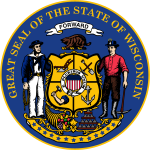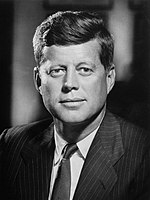| ||||||||||||||||||||||||||
| ||||||||||||||||||||||||||
 County Results
| ||||||||||||||||||||||||||
| ||||||||||||||||||||||||||
| Elections in Wisconsin |
|---|
 |
The 1960 United States presidential election in Wisconsin was held on November 8, 1960 as part of the 1960 United States presidential election. State voters chose 12 electors to the Electoral College, who voted for president and vice president. Politics in Wisconsin since the Populist movement had been dominated by the Republican Party.[1] The Democratic Party became uncompetitive away from the Lake Michigan coast as the upper classes, along with the majority of workers who followed them, fled from William Jennings Bryan’s agrarian and free silver sympathies.[2] Although the state did develop a strong Socialist Party to provide opposition to the GOP, Wisconsin developed the direct Republican primary in 1903 and this ultimately created competition between the “League” under Robert M. La Follette, and the conservative “Regular” faction.[3] This ultimately would develop into the Wisconsin Progressive Party in the late 1930s, which was opposed to the conservative German Democrats and to the national Republican Party, and allied with Franklin D. Roosevelt at the federal level.
During the two wartime elections, the formerly Democratic German counties in the east of the state – which had been powerfully opposed to the Civil War because they saw it as a “Yankee” war and opposed the military draft instituted during it[4] – viewed Communism as a much greater threat to America than Nazism and consequently opposed President Roosevelt’s war effort.[5] Consequently, these historically Democratic counties became virtually the most Republican in the entire state, and became a major support base for populist conservative Senator Joe McCarthy, who became notorious for his investigations into Communists inside the American government. The state’s populace’s opposition to Communism and the Korean War turned Wisconsin strongly to Republican nominee Dwight D. Eisenhower in the 1952 and 1956 presidential elections.
The 1958 midterm elections, however, saw a major change in Wisconsin politics, as Gaylord A. Nelson became only the state’s second Democratic Governor since 1895, and the state also elected Democrats to the position of treasurer and Senator, besides that party gaining a majority in the State Assembly for only the second time since the middle 1890s. In the spring, despite anti-Catholic suspicion, polls indicated that Kennedy would defeat Nixon in Wisconsin.[6]
During the fall campaign, polls at the end of September showed that Nixon had gained,[7] due to the religion issue and Eisenhower’s success in achieving a level of peace with the Soviet Union. The state’s Republican Party stressed achievements in peacemaking, whilst Kennedy’s October visit to the state would stress failures in the farm sector during Eisenhower’s administration.[8] In the November election, the state fluctuated before Nixon ultimately carried Wisconsin by a relatively comfortable 3.72 point margin.[9] As of the 2020 presidential election[update], this was the last time a Democrat won the presidency without winning Wisconsin, although the party won the popular vote without the state in 2016. This was also the last time Wisconsin would back the overall losing candidate in a presidential election until 1988.
- ^ Burnham, Walter Dean; 'The System of 1896: An Analysis'; in The Evolution of American Electoral Systems, pp. 178-179 ISBN 0313213798
- ^ Sundquist, James; Politics and Policy: The Eisenhower, Kennedy, and Johnson Years, p. 526 ISBN 0815719094
- ^ Hansen, John Mark; Shigeo Hirano, and Snyder, James M. Jr.; ‘Parties within Parties: Parties, Factions, and Coordinated Politics, 1900-1980’; in Gerber, Alan S. and Schickler, Eric; Governing in a Polarized Age: Elections, Parties, and Political Representation in America, pp. 165-168 ISBN 978-1-107-09509-0
- ^ Phillips, Kevin P.; The Emerging Republican Majority, pp. 381-382, 414 ISBN 978-0-691-16324-6
- ^ Phillips; The Emerging Republican Majority, pp. 387-388
- ^ Otten, Alan L. and Novak Robert D.; ‘Nixon’s Chances: He Faces Uphill Fight For Presidency, a Poll In Wisconsin Indicates – Vice President Loses Many Independent Ike Backers’; The Wall Street Journal, March 31, 1960, p. 1
- ^ Blair, William M.; ‘Nixon Ahead as Wisconsin Area Switches Votes: District Has Reputation for Switches and Trends Religion and Peace Appear to Be Major Issues’; Special to The New York Times, September 29, 1960, p. 24
- ^ Wehrwein, Austin C.; ‘G.O.P. in Wisconsin Stressing “Peace”: But Democrats Call Farmer Discontent Main Issue – Religion Is a Factor’
- ^ ‘Nixon Regains Lead In Wisconsin Fight; Spurs State Ticket’; The New York Times, November 9, 1960, p. 25
© MMXXIII Rich X Search. We shall prevail. All rights reserved. Rich X Search


